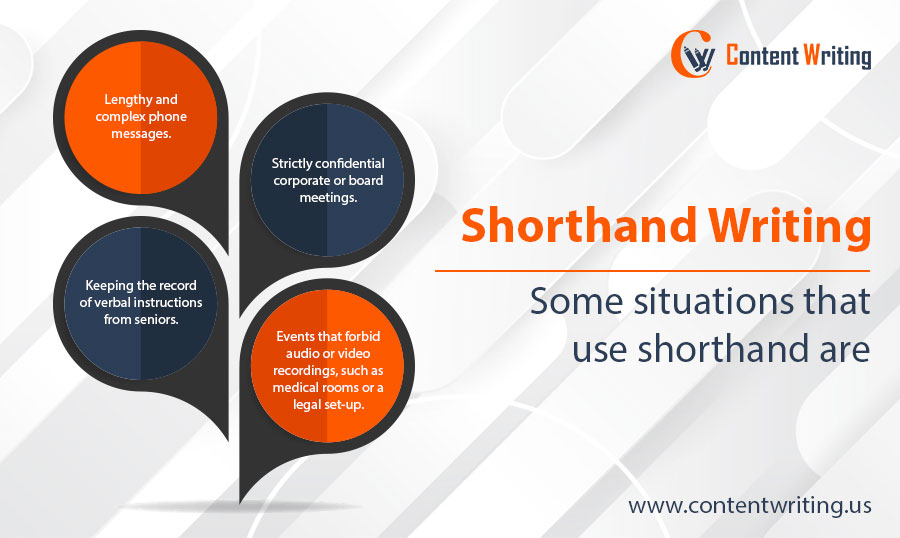Writing is a requisite for both, academic and professional life. So, how about speeding up your writing skills and speeding up the processes? Not only it will help in keeping up with the daily lectures, but would also serve wonderfully in the career ahead. Shorthand writing is one such technique that accelerates your writing speed.
Let’s discuss what shorthand is and its different types. Furthermore, we will discuss how you can develop the skills of shorthand writing and why is it so valuable.
Also, read: How to Improve Your Content Writing Skills?
What Is Shorthand Writing?

Shorthand is a system of rapid writing that utilizes abbreviations or symbols to represent words, phrases, or letters. Writing shorthand quickens your handwriting speed, as compared to the traditional way of writing.
This way, your pen transforms into a highly powerful tool, better than any existing technology. There is no digital intervention. You get to follow the old-fashioned manuscript way. Just, a little more advanced and technical.
Since shorthand shows quick results, various professions utilize it. For instance; journalists use it while attending important events. Even courtroom professionals use it during hearing sessions. It is more rapid than orthography or normal spelling.
Some situations that use shorthand are
- Lengthy and complex phone messages.
- Strictly confidential corporate or board meetings.
- Keeping a record of verbal instructions from seniors.
- Events that forbid audio or video recordings, such as medical rooms or a legal set-up.
The History Of Shorthand: How It Was Invented!
The shorthand technique is not new to us. It has been in existence for a long time. It was introduced prior to the dictation and recording machines. In fact, the first shorthand system was invented in Greece, Egypt, and China. It was before the 5th century CE.
Therefore, it would be safe to say that shorthand became popular due to its efficiency and feasibility. Of course, that could have been the major reason why shorthand became popular across the continents.
Another key purpose that shorthand served was catching up with the speech. After all, the delivery of a speech is faster than normal writing speed. You can look through a few examples of shorthand writing to understand it better.
Moreover, the law court proceedings and philosopher’s lectures were other significant factors that lead to the demand for a shorthand writers in these fields.
Contemporary Forms Of Shorthand Writing

-
Pitman Shorthand
In the modern system of writing, the first shorthand system was developed in 1837 by Sir Issac Pitman. It is known as Pitman Shorthand and utilizes symbols to denote the sounds produced by words. In fact, this form remains to be popular in the UK even at present.
This system has inspired numerous individuals who practice it widely. As a result, consistent practice and research are evident. Moreover, you can find a significant volume of information about it online.
-
Gregg Shorthand
It is interesting to know that the inventor of the Gregg Shorthand system, John Robert Gregg, himself studied Pitman Shorthand. Something clicked in his mind so he decided to make a few tweaks in the Pitman’s system.
The Gregg Shorthand system was developed in 1888. It remains to be a popular method of pen stenography in Latin America. The system utilizes phonetics and alphabets. Moreover, this method has been revised several times in an attempt to make things simpler.
-
Teeline Shorthand
Developed in 1968 by shorthand writer and teacher of Pitman Shorthand James Hill, Teeline is a fairly recent form of shorthand system. Journalists often use it during the Commonwealth. It is certainly becoming quite popular among people in Canada and the US.
Teeline uses alphabetic in its system. Moreover, Teeline is perceived as a modern-day shorthand example. Why? Although it is less effective yet comparatively easier to learn and adapt.
Writing In Shorthand: The Fundamentals Of Shorthand Systems

Now comes the most interesting part!
Let us help you understand how to write in shorthand.
Step 1: Selection Of A System
Our initial approach would be choosing a system of shorthand. It would depend on a lot of factors. This includes the amount of time you can dedicate, how quickly you wish to ace the skills, etc.
So, where should we start? As per the research and observations, the recent versions of Gregg and Pitman shorthand systems are easier to learn. For instance New Era Pitman, Gregg Pre-Anniversary, and Gregg Anniversary.
Those who are bound due to time constraints should go for Pitman 2000 and Gregg Diamond Jubilee. They are quick to learn.
Also, read: Popular Types Of Content Writing
Here are some of the major shorthand systems that you can pick from.
-
Pitman Shorthand
You can judge the efficiency of this shorthand system by the fact that it enables you to write at the speed of 200 words per minute.
Moreover, it follows the style of thick and thin strokes. They signify various sounds. Hence, a pen with a steel tip is appropriate for this system. It primarily utilizes dots and dashes while scribbling.
-
Gregg Shorthand
This system of shorthand uses circles to represent vowels. Besides, symbols are used for memorizing. Gregg shorthand system comparatively takes longer to learn.
Similar to the Pitman shorthand system, a shorthand writer can write 200 words per minute following this system.
-
Teeline Shorthand
The Teeline system is primarily based on the alphabet. Moreover, it uses smaller consonants and vowels. We need to keep essential letters in the central focus.
Journalists highly use Teeline. It helps them note down the important things quickly.
Step 2: Collect The Relevant Learning Material
After you have picked a shorthand system that best matches your requirements, it is time to garner all the resources.
What could be a better option than the web itself?
The first thing you need to do is find videos and blog tutorials to pace up your learning journey. Moreover, go through a few shorthand writing examples.
Next, start practicing the form and stay consistent in it.
You may also check out some YouTube tutorials for an elaborate explanation of the subject. The step-by-step learning process is the most appropriate way to upskill.
Furthermore, you can look for bookstores, local libraries, and even online bookstores. They also make for quality educational resources for gaining knowledge on these systems.
Even, some old test kits would be a good place to accelerate your understanding. Such kits include manually drafted notes and recordings to help you with writing shorthand.
Additionally, there are shorthand dictionaries. It helps you get an insight into the formulation of different words in shorthand.
Must read: Significance of Evergreen Content
Step 3: Persistent Practice To Achieve Perfection
As you decide to learn shorthand, prepare yourself with the mindset that learning shorthand would require a considerable amount of time.
So, do not fall into the unrealistic claims of teaching shorthand quickly. There’s no short route to shorthand.
You must take your time while learning shorthand. The skill requires focus and practice. Stay consistent with your efforts and you will master the technique soon.
Further, it will help in building the speed quotient. As you become more familiar the perfection will start showing up.
Moreover, you must be careful with the errors. Try not to commit a lot of mistakes. However, they are bound to happen.
So, your entire focus should be on learning from them and reducing them.
If you are slow initially, do not worry. The speed would increase eventually as you get comfortable with the shorthand system.
As we already mentioned, you cannot achieve anything without proper practice. Writing shorthand might seem daunting at the start. But, with each passing day, you will improve.
Thus, making a routine and dedicating a few hours exclusively to practicing shorthand. Repeating the letters and writing style is the key. Either record yourself or ask friends and family to conduct a test.
Must read: Key Elements Of Good Content Writing
Alternatives Of Established Shorthand Systems

Those who have a shortage of time can explore alternative methods of learning shorthand. Stenoscript and speed writing are some popular ones. They utilize ordinary alphabets for this purpose.
In fact, one can always invent their own system for shorthand. It would make things easier and you would understand everything clearly.
Let us look at some of the shorthand alternatives apart from the universally accepted and adopted systems.
-
Bell’s Invisible Speech
The original purpose of inventing this system was to record any human speech. Hence, it works on the principle of reducing the vocals into symbols.
-
HandyWrite
HandyWrite shares the features of the Gregg shorthand system. Moreover, it utilizes similar consonants, symbols, and strokes as Gregg’s. The strokes are fast and cursive.
-
Blissymbolics
This system utilizes descriptive pictures. It represents concepts instead of words. It is interesting to know that the system was developed for universal use. The idea was to surpass the language barriers and communicate.
Technology and Shorthand Writing: A Remarkable Combination
In 1906, an American stenographer and court reporter, Ward Stone Ireland, invented the stenotype machine. This is when the commercial use of machines for speech recording became possible.
Today, offices widely use stenotype machines and stenographs. However, the chief purpose is manual recordings of courtroom reporting and conferences.
The machines have keyboards with 22 keys. Moreover, the stenographer’s all fingers and both thumbs are involved. Thus, making it possible to strike any set of keys simultaneously. A strip of paper is inserted into the machine. Roman letters are printed on it with each strike.
Keys are operated with touch. Therefore, the operator can watch the speaker. The left hand’s fingers are used to print the consonants. They occur before vowels. These keys print on the left end of the tape. Vowels are controlled by the thumb. Further, they print on the tape’s center.
The right hand’s fingers control consonants followed by vowels. They print on the left end of the tape.
Each English alphabet does not have a separate key. Letters without any key use a combination of letters. Abbreviations replace frequently appearing words. It allows the operator to type 2-3 words per stroke.
What Makes Shorthand A Significant Skill?
To begin with, shorthand fastens up your normal writing speed. Generally, a person can only write up to 20-30 words in a minute. It is quite slow to manually record a speech.
However, shorthand empowers you to write approximately 200 words per minute. Isn’t that impressive?
Both forms of handwriting serve distinctive purposes. If you have the prowess of writing shorthand, several excellent career opportunities are awaiting you! From personal secretaries and assistants to journalists, professionals need to incorporate shorthand into their routines.
Further, shorthand is highly useful in penning down the integral details while your boss is instructing you. Skilled shorthand specialists perform an amazing job in locating and rectifying the errors made by voice recognition software.
When it comes to personal life, shorthand writing helps in improving hearing, summarizing, and memory skills. Besides, enlisting shorthand writing skills in your resume creates a great impression. If you know how to write in shorthand, you can save a lot of your time. Thus, improving your productivity in various other fields.
Also, read: Article Writing: All You Need To Know About It
Career Options For A Shorthand Writer

Many people assume that technology has replaced shorthand. However, that is not true! In fact, shorthand writing has extended its roots throughout the world.
Besides, the videos and audio recordings are not applicable or sufficient sometimes. That’s when manual documentation of events comes into the picture.
Are you considering learning how to write in shorthand, but feel unclear about the career options? Let us be your guiding light!
Career In Shorthand
-
Court Reporters
The local, federal, or state government requires shorthand professionals to note down the conversations in the courtroom. This could be opening and closing statements, testimony, motions, arraignments, jury proceedings, etc.
-
Medical Transcriptionists
Examples of shorthand writing can be found in the medical field too. It includes listening to the recordings by physicians and other healthcare professionals.
Thereupon, transcribing them. For instance, emergency visiting reports, operations, final summaries, chart reviews, and diagnostic imaging studies. Lately, there has been a surge in the demand for medical transcriptionists.
-
Freelance Reporters
The freelance reporters are not associated with any institution. They work independently. Shorthand serves greatly while writing depositions, statements, arbitration, working as a substitute for official courtroom reporters, meetings for the board of directors, etc.
Basically, the job is to manage a verbatim copy of vocal statements. You can even take up the job of corporate reporter. Moreover, they handle the minute of meetings happening in the organization such as acquisitions, meetings, and more.
-
Legislative Reporters
Their job is to maintain manually scripted records of proceedings in the legislative bodies. Further, immediate reports for the public are also prepared. Someone with sound knowledge or interest in the law would really enjoy the nature of work.
-
Closed Captioning Reporters
They generally work for television programs and news. Such reporters also cover sports events. Moreover, the events that demand instant scripting for hearing-impaired audiences need shorthand writing.
-
Military Reporters
Armed forces directly train military reporters. Further, the responsibilities include manually recording military proceedings such as Court martial, and tribunals.
-
Communications Access Realtime Translation Reporters
CART is the shorthand expert who assists hearing-impaired individuals. They are appointed in government agencies, schools, and colleges.
At the high-school level, the work includes reporting verbatim on class lectures. Additionally, they participate in school meetings to prepare notes for the hearing-impaired students.
Colleges integrate shorthand for simplifying CAT software learning and facilitating skill set development. It is an attempt to help students who are hard of hearing. Consequently, the participation of students improves.
-
Scoplsts
The duty of a scoplsts involves correcting, editing, and adding to the transcripts submitted by reporters. It utilizes a Computer-Aided Transcription system for the execution.
One of the major requirements to become a scolpsts is having sound knowledge of English. Moreover, it demands strong research skills, a fair understanding of terminologies, figuring out the acronyms, etc. There is a huge scope in this field, all across the globe.
Final Words
Shorthand was first developed as merely a form of rapid writing technique. However, with time it has evolved as a major skill required in many professions. It wouldn’t be wrong to describe shorthand as a technology. Ever since its inception, the shorthand system has witnessed some major tweaks.
The latest tools and practices such as stenography have been given tough competition to shorthand. However, the uniqueness of shorthand is irreparable. Hence, the technique remains to thrive despite the recent advancements.
Even some content writing company professionals are also well-versed in shorthand skills. Knowing an extra skill serves as a bonus and helps in the career path. We hope you found this blog insightful!
Our Related Blogs:
What is Content Writing? Tips to Write Compelling Content
